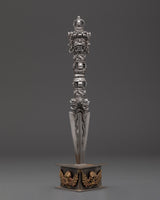
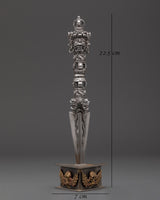
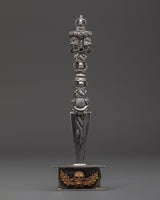


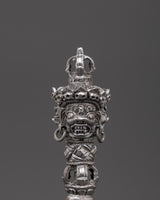

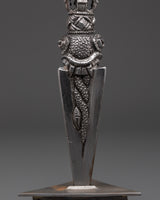
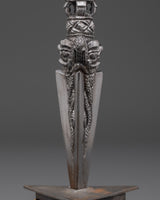
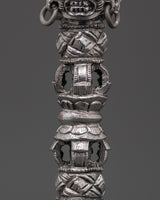
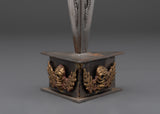

Handcrafted Phurba Tibetan Dagger | Meditation Tool

100% AUTHENTIC

HANDMADE

FREE SHIPPING
Handcrafted Phurba Tibetan Dagger | Tantric Ritual Item
--------------------------------------------
Size: 22.5cm(Height) x 7cm(Width)
Weight: 0.40kg
Materials: Iron
--------------------------------------------
About The Ritual Item :
The Handcrafted Phurba Tibetan Dagger is a sacred ritual tool rooted in centuries of Tibetan Buddhist practice. This iron dagger, measuring 22.5cm in height and 7cm in width, is more than just a decorative piece it's a potent spiritual tool utilized in Tantric rites to subdue evil energies and ground divine intent. The Phurba, traditionally connected with Vajrakilaya, the deity of wrathful compassion, channels transforming energy, making it an indispensable tool for Tibetan Buddhists, meditation practitioners, and ritual workers.
Crafted from iron and weighing 0.40 kg, this dagger exemplifies superb Tibetan artistry and metaphorical profundity. The triple-bladed point depicts the cutting through of ignorance, desire, and aversion, the three root poisons of Buddhism. Every detail, from the delicate handle to the ferocious god image on the hilt, is fashioned with spiritual intent. This handcrafted Tibetan Phurba, ideal for altar display, ceremonial use, or meditation, provides protection, focus, and clarity to spiritual practices. Whether you're a collector, practitioner, or spiritual seeker, this Phurba Tibetan Dagger is a powerful addition to your sacred space. As a handcrafted spiritual tool, it promotes ceremonial grounding and energy transmutation.
Introduction To The Phurba :
The ceremonial dagger (Sanskrit: Kila; Tibetan: phurba) is essential for expelling evil and is considered particularly effective in neutralizing the forces that obstruct Tantric Buddhist practice. It has ancient origins, first appearing in the Indian Rg Veda as the core blade of the vajra used by Indra to destroy the primordial cosmic snake Vritra. Kila, a term derived from Sanskrit, was most likely associated with Vedic sacrifices. Meditation on the Vajrakila Tantra, an early Indian scripture first promoted in Tibet in the eighth century by Padmasambhava, one of the founding teachers of Tibetan Buddhism, is used to invoke the three-headed Vajrakila Buddha.
How to Set Up Your Own Buddhist Shrine?
Find a clean, quiet, and uncluttered spot
Set up an altar table, and cover it with an altar cloth that calls to you
Place your sacred item (statue, thangka, or a picture of Buddha) at the center






















